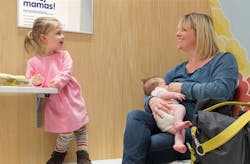In a 2017 issue of Cosmopolitan magazine,1 Tammy Duckworth, a U.S. Senator from Illinois, wrote an opinion piece about the need for lactation rooms in airports. According to Duckworth:
As a member of Congress when my daughter was born, I was traveling a lot for work. . . . As a nursing mother, I had to stick to a feeding and expressing schedule, including when I was at the airport, but I quickly realized that finding a clean, accessible, private space was stressful and inordinately difficult. . . . At many airports, I was redirected to a bathroom, forced to pump in a bathroom stall.
Duckworth went on to say her experience in U.S. airports is all too common. She referenced a study published in 2014 that reported the following:
Only 8 percent of the airports surveyed provided the minimum requirements for a lactation room. However, 62 percent stated they were breastfeeding friendly. Airports need to be educated as to the minimum requirements for a lactation room.
As a result of her article and with the support of Representative Stephen Knight of California, a bill was finally passed that required the Federal Aviation Administration (FAA) to require lactation rooms in all midsize and large airports in the United States. Not only were these rooms required, but the bill was very specific as to how they were to be designed. For instance, it stated lactation rooms are to have the following characteristics:
- Be shielded from public view or intrusion
- Be a private place that is lockable (but unlocked when not in use)
- Be readily available to people with disabilities
- Have a place to sit as well as a table for the baby
- Include a sink and electric outlets
- Be located in each terminal after security checkpoints
- Not be inside a restroom in the airport.
Passage of the bill won immediate support from various organizations, including the United States Breast Feeding Committee (USBC). "This is a strong step forward toward a world where breastfeeding families across our country are seamlessly supported wherever they are—at their places of work, in their communities, in an airport, anywhere," said Mona Liza Hamlin, chair of the USBC.
To help airport administrators get on board, the bill also provided grants for the building of these lactation rooms.
Floorcare Concerns
When it comes to cleaning lactation rooms, some airport administrators and cleaning professionals may suspect they should be cleaned in more traditional ways with mops, buckets, sprayers filled with cleaning solution and disinfectants, and cleaning cloths. However, these are special rooms, and because of this, they have special cleaning needs.
A key concern is the floor. Very often a mother will allow her baby a few minutes to crawl on the floor after feeding, especially at an airport where crawling activities and a little exercise are at a premium. This is a very big cause for concern.
Many mothers walk in and out of lactation rooms throughout the day. Whatever soils or pathogens are on their shoe bottoms have likely been transferred to the floor of the lactation room and could be transferred to the hands of the baby. Further, a baby may have “accidents” in the lactation room. Although the mother may clean this up, removing visible signs of the accident, hidden pathogens may still cover the floor.
Although we cannot expect cleaning professionals to clean these rooms or their floors after every use, what we can do is make sure the cleaning tools they use do not make the situation worse. The first step when it comes to proper lactation room floorcare is to not use mops.
We know mops collect and then spread contaminants on floors as they are used, and far too many mops are used in airports. Very likely, the cleaning worker is using the same mop to clean restrooms, food service areas, walkways, and other areas throughout the airport. The mop quickly becomes covered with pathogens, as does the mop water and the floors that are cleaned with it.
There are alternatives, however. Depending on the room construction (water-safe walls) vacuum-enabled mop alternatives such as dispense-and-vac or what ISSA, the worldwide cleaning association, calls "spray-and-vac" systems are options. These systems apply cleaning solution to floors, walls, and other surfaces. All moisture as well as soils are then vacuumed up. It is also recommended to use a cleaner/disinfectant with these systems. The cleaner helps removes soils from surfaces, allowing the disinfectant to "kill" any germs or bacteria on them.
Surfaces
As to the cleaning of surfaces in the lactation room, such as chairs, tables, sinks, counters, and high-touch areas such as light switches and doorknobs, airport administrators and cleaning professionals are advised to follow very strict cleaning protocols and guidelines. However, there are no specific guidelines for cleaning lactation rooms.
Given the sensitivity of lactation rooms, it makes sense to follow some of the recommendations provided by the Centers for Disease Control and Prevention (CDC) for cleaning patient rooms in hospitals.
Among them are the following:
- Cleaning professionals should always wear protective gear, specifically gloves, when cleaning lactation rooms.
- All the surfaces mentioned earlier should be cleaned and disinfected; in many cases, this is a two-step process—clean first, then disinfect.
- Use a fresh cleaning cloth each time a lactation room is cleaned; just like mops, the cleaning cloth can harbor scores of germs and bacteria.
- Because there may be uncertainty as to the nature of the soils or contaminants on surfaces, use an EPA-registered, broad-spectrum disinfectant, designed to kill many different types of bacteria and pathogens.
- Follow all protocols as to diluting the disinfectant along with surface “contact time” before wiping; this can be as much as 10 minutes with some disinfectants.
- To remove potentially hazardous spills on the floor, a spill kit is recommended. Use the spill kit to cover and absorb the spill. The area should then be cleaned and disinfected using a floor-cleaning alternative such as an auto vac system, mentioned earlier.
- Do not use chemical sprayers, fogs, or mists to disinfect these rooms; do to effectiveness issues, the CDC does not support the use of these products in hospitals, so they should not be used in lactation rooms.
To speed the cleaning process, another option airport administrators and cleaning professionals have is to use is what ISSA, the worldwide cleaning association calls, small to midsize spray-and-vac cleaning system. These systems typically cut cleaning times in half or more.
As to the lactation law, there is one more provision we should mention. It also requires that baby changing stations be installed in both men’s and women’s restrooms in each terminal. It appears the goal of this new law is to make flying more relaxed and more comfortable, not only for moms and dads, but for months-old future travelers as well.
Robert Kravitz is a frequent writer for the professional cleaning industry.




